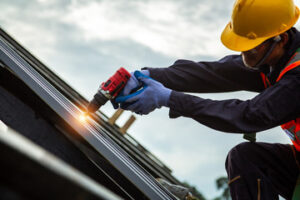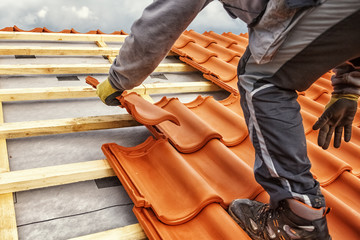Getting regular professional roof inspections and addressing small problems can help you avoid costly repairs down the road. Learn about factors that affect roof repair costs, like local labor rates and the availability of specialized materials.
Identifying leaks and other problems before they become severe can save you a lot of money and stress in the long run. Look for the following problems to watch out for. Visit https://www.fivestarroofingandcontracting.com/ to learn more.
 Shingles and tiles are more than just aesthetic features on your roof; they provide a critical barrier against rain, wind, and sun that protects the underlying structure of your home. Damaged shingles or tiles can compromise this function and lead to leaks and other costly problems.
Shingles and tiles are more than just aesthetic features on your roof; they provide a critical barrier against rain, wind, and sun that protects the underlying structure of your home. Damaged shingles or tiles can compromise this function and lead to leaks and other costly problems.
Checking shingle condition regularly is the best way to spot and repair early signs of damage. Shingles that are loose, cracked, or chipped need to be repaired right away. These small gaps in your roofing system allow moisture to enter and compromise the integrity of the underlying wood decking. The same goes for shingle areas that are missing entirely; this gaping hole in your roof’s defenses needs to be plugged immediately.
Inspect your roof for any shingle areas that look dark or discolored. This could be a sign that the granules that coat asphalt shingles are falling off and leaving the asphalt exposed. This can quickly cause the shingles to deteriorate and leave your home vulnerable to water damage. Look for moss or algae growth on your shingle roof as well; this is another clear indicator that your shingles are starting to wear out and need to be replaced.
If you have a tile roof, examine the tiles for any cracks or chips. These need to be repaired as soon as possible to prevent further cracking and deterioration of the surrounding tiles and the underlying support system. Cracked or broken tiles can let in moisture, which can lead to wood rot and mold growth in the attic. This can also lead to extensive and expensive damage to your interior and exterior walls.
When repairing damaged shingles or tiles, always use materials that are compatible with your existing roof. Mismatched materials can not only look unattractive, but they can also accelerate corrosion due to galvanic reactions with different metals. A professional can provide advice and recommendations for the best patching materials for your particular roof. In addition, a professional can use specialized tools and knowledge to ensure that your repair is strong and durable. This can make a significant difference in the longevity of your repairs and the effectiveness of your roof’s protection.
Leaks
When a leak is not repaired promptly, it can cause serious water damage to the structure and interior of your home. Leaks can be caused by missing shingles, deteriorating flashing, or a faulty gutter system. It is important to inspect your roof for signs of a leak, such as water stains on the ceiling and walls, puddles in the attic, and a musty smell from damp insulation.
You can also look for water stains on the outside of your home near the rooftop vents, chimneys, skylights, and dormer windows. If you see a stain, it’s a good idea to contact a professional roofer for an inspection and repair assessment.
Detecting a leak can be tricky. Start by taking a walk around your home, checking for signs of a leak inside and out. Water stains on the ceiling and walls, a musty smell in certain rooms, rotting framework wood, and damp insulation are all indicators of a leak. Once you’ve spotted these signs, look for the source of the leak on your roof.
If you can’t find the source of the leak, you can use roofing cement or caulking to seal any cracks. Apply these to any areas of your roof where you have a gap or exposed fasteners, especially in the areas around roof vents and pipes.
Another way to identify a leak is to look for a sagging bulge in your ceiling. These are a sign that your roof is leaking and can lead to structural damage and mold growth. If you notice a bulge, puncture it with a screwdriver to drain the water and prevent it from spreading or bursting.
While you’re inspecting for leaks, make sure to check the area of your roof closest to the suspected leak. If the problem is a loose or damaged shingle, it’s best to hire a professional roofer to replace it. If it’s a faulty flashing, remove the existing material and carefully clean the area. Install new flashing and apply roofing cement to create a strong seal.
Before beginning a DIY project, it’s essential to have all the necessary tools and someone to help you. Attempting to repair a roof without the right equipment could result in voiding your warranty and causing more damage. It is also important to prioritize safety when conducting a roof repair project, ensuring you wear the proper footwear and protective gear while on the roof.
Sagging
A roof is designed to support a certain amount of weight, and when the structure is overwhelmed by more than this it can start to sag. This can lead to structural problems throughout the home, requiring expensive repair or replacements. To prevent this, regular inspections of the roof and maintenance are necessary. Professional roofing contractors are trained to spot early signs of sagging and can provide repairs or reinforcements to stop the problem in its tracks.
Sagging in the roof is not necessarily a cause for alarm, but it should never be ignored. If left untreated, the problem can worsen over time, and it is often a sign that a more serious issue is at hand. For example, if one area of the roof is sagging but other areas are fine, it could mean that the sagging area is caused by a weak or damaged truss.
A sagging roof is not only an eyesore, but it can also have a significant impact on the overall appearance of your property. It can also affect how passersby view your home and reflect negatively on the standard of care you have for your house.
In addition to sagging, other symptoms of roof damage include creaking sounds in the attic or elsewhere in the house, cracking walls, and doors that are difficult to open and close. Addressing these issues promptly by seeking professional help can save you money in the long run and ensure that your roof is structurally sound for years to come.
Sagging roofs are often caused by excess load, which can be the result of water damage or weakened support structures. Performing frequent roof inspections, including cleaning gutters and removing debris can help to reduce the risk of excess weight becoming a problem for the roof.
Water Damage
A leaking roof can lead to serious water damage inside your home. Water can stain and discolor materials, damage wood beams and trusses, and promote mold growth. If left untreated, the moisture can cause significant structural problems and lead to expensive repair bills.
If you discover a leak in your home, act quickly to prevent further water damage. Remove any items that may get wet and move them to a dry area. You can also place buckets or containers under the leaking spot to collect any water that drips onto the floor. It’s also a good idea to take photos or video of the affected areas, which can be useful for insurance claims.
Before beginning any repairs, it’s important to make sure the surface is clean and dry. Scrape away any dirt, debris, or mold that has accumulated due to water exposure. This can help prevent further moisture-related issues and ensure proper adhesion or installation of the repair materials.
Then, inspect your roof for any obvious signs of damage. Look for sagging, cracks, or missing shingles. Check the flashing around vents, chimneys, skylights, and walls, and repair or replace any that are damaged or worn out. Check for ice dams during the winter, which can be a common cause of roof leaks.
Moderate Repairs ($500 – $1500)
Moderate repairs cover more extensive damage but don’t require replacing the entire roof. This could include repairing numerous leaks, replacing several shingles, and addressing mild structural problems.
Comprehensive Repairs or Replacement ($1500 – $5000+)
Complete roof replacement is usually required when severe underlying damage has occurred. This type of work can be very costly and is typically best done by a professional roofing contractor. This is typically needed when there are numerous leaks, major structural damage, or if the roof is approaching the end of its service life.


